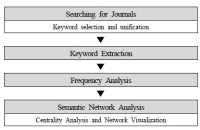
[Purpose] The purpose of this study was to identify research trend regarding pro-sports and visualize keyword network by using semantic network analysis. [Methods] After searching researches about pro-sports from 1994 to 2016, total 686 researches selected. In this process, inappropriate researches were excluded by 2 researchers’ consensus. [Results] First, the distribution of the number of researches were arranged on pro-baseball, pro-football, pro-basketball, and pro-volleyball in that order. Second, fan, team, and athletes were main research subject. Third, quantitative researches were dramatically more than qualitative researches and mixed method researches. Forth, the proportion of co-working have increased with the course of time. Fifth, the number of keyword which are appeared in researches has increased with the course of time, it dramatically was increased at 2010. [Conclusion] Through these results, researches regarding pro-sports have been broaden with the course of time and interdisciplinary convergence researches with adjacent fields were performed. However, some keyboards were repeated and academic interest about rare keywords was decreased with the course of time. Therefore, scholars in sports field need to have a inquiring stance about novel variables and phenomenons





Purpose The purpose of this study was to examine the difference and consistency of kinematic variables for each athlete by selecting the official records of the world's elite female triple jumpers to evaluate the performance level. Methods Three athletes who won the prizes at the World Championships Daegu 2011 Women's Triple Jump were selected as the study subjects, and only the successful trials were used for analysis. Pearson's correlation analysis was conducted with the kinematic variables in the hop, step, and jump phase, respectively. Also, kinematic variables with statistically significant correlations between braking time and pushing time and related variables were described separately. The duty factor and support factor for the hop, step, and jump of support phases were calculated. Results The successful trials rate were 66.7% for Olha, 50% for Olga, and 83.3% for Caterine. In the last three stride distances of the approach run, Olha and Caterine had a “medium-long-short” pattern and Olga had a “long-short-medium” pattern. There was no difference in the duty factor value between hop and jump phases in the ‘hop-dominate’ technique type, but there was a difference in the jump phase in the ‘balance’ technique type, and the duty factor value in the step of both technique types was greater than that of hop and jump phases. As for the percentage of the support factor, Olha and Caterine had a characteristic that the percentage of braking time in step and jump phases was opposite. On the other hand, Olga had the same percentage for the hop and step phase, and a smaller percentage for the jump phase. Conclusion To increase the accuracy of the board touch-down, maintain a certain last stride(1SL) depending on the technique type. This consistency of the approach run increases reduces distance loss on the take-off board and increases the successful rate of each trial. The duty factor can judge both the performance level and the technique type of triple jump, and the support factor is a variable that can classify the technique types of hop, step, and jump phases. If both the relative time required for the triple jump and the variability of the support time(braking and pushing) for each phase are constant, the difference in records by trial will be small.


Purpose: This study was to verify the relationship between coaching behavior(autonomy/controlling behavior), self-regulation motivation and performance. Method: 356 athletes (from middle to work and professional team) in individual and team sport completed coaching behavior scale developed by this researchers assessing autonomy and controlling coaching behavior perceived by players, Korea Basic Pyshoclogical Needs Scale (KBPNS) assessing basic psychological needs, Behavioral Regulation in Sport Questionnaire (BRSQ) assessing sports motivation level based on self-determination theory, and sport performance score. To estimate the relationship between coaching behavior, self-regulation motivation and performance, this study employed the structure equation modeling analysis. Results: The relationship between psychological needs, regulation motivation and performance showed that autonomy coaching behavior tend to reinforce competence and autonomy of player. These variables have a positive effect on more inner regulation motivation. Moreover, the intrinsic motivation through stimulation experience was a key factor leading to a positive performance by improving the performance strategy and skill of athletes. Conclusion: These results are meaningful as an empirical evidence that relationship between motivation and performance can be changed according to the type of coaching behavior, and that autonomous coaching behavior play an important role in maximizing the performance of player that provided theoretically form.

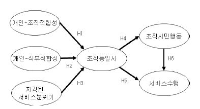
The purpose of this study is to empirically inquire into the relationship between a commercial sports center employee's person-environment fit(person-organization fit., person-job fit) & perceived service climate and organizational identification, organizational citizenship behavior and service performance through structural equation model analysis. For this purpose, this study conducted a questionnaire survey of 207 employees working at 12 commercial sports center(a facility in possession of more than 3 events). In an effort to verify the proposed structural model, this study used SPSSWIN Ver. 21.0 and AMOS 18.0. The research results are as follows: First, it was found that person-organization fit had an influence on organizational identification. Second, person-job fit was found to have an influence on organizational identification. Third perceived service climate was found not to have a positive influence on organizational identification. Fourth, organizational identification was found not to have a positive influence on organizational citizenship behavior, either. Fifth, organization identification was also found not to have a positive influence on service performance. Sixth, organizational citizen's action was found to have a positive influence on service performance.


Purpose The purpose of this study was to compare the technique and power of the Korean national athletes and international athletes in the start phase of the 500 m speed skating to improve the performance and to understand the relationship between the biomechanical variables affecting the record. Method The subjects were 8 Korean national athletes (Korean athletes) and 6 international athletes (international athletes). For the three dimensional motion analysis, 5 high-speed cameras were used to capture the 40 m start phase of the athletes participating in the international competition. The variables selected for analysis were the kinematic chain, 100 m net time, time to 9 strokes, horizontal position of center of mass after 2.5 sec, range of motion of trunk, knee, push-off angle, net power output, total power loss. Results The correct kinematic chain ratio of Korean athletes was 61.2%, which was lower than 76.0% of international athletes. The time to 9 strokes was 2.82±0.25 sec for Korean athletes, which was significantly lower than 2.53±0.11 sec for international athletes (p=.001). The range of motion of the push-off angle was 60.15±2.75° for Korean athletes, which was significantly lower than 64.76±2.55° for international athletes (p=.001). The net power output was 887.2±269.9 W for Korean players and 1103±264.1 W for international players (p=.021). The variables related to the 100 m net time were the horizontal position of center of mass after 2.5 sec (r=-.956, p=.001), the net power output (r=-.931, p=.001), and the total power loss (r=-.904, p=.001). Conclusion In order to improve the start performance of Korean athletes, it is necessary to maximize the efficiency of skating through skill training to use the correct kinematic chain. Also power enhancement training is needed to improve leg power because the net power output related with 100 m net time.


PURPOSE The purpose of this study was to analyze the effect size of the unified theory of acceptance and use of technology (UTAUT) in the sports field using a meta-analysis. METHODS After identifying related studies by using RISS, 22 articles were selected and used to analyze the relationship between UTAUT sub-factors (performance expectancy [PE], effort expectancy [EE], social influence [SI], and facilitating conditions [FC]) and intention to use via the comprehensive meta-analysis program. RESULTS The results are as follows: First, the effect size between PE and intention to use was 0.521. Second, the effect size between FC and intention to use was 0.514. Third, the effect size between EE and intention to use was 0.500. Finally, the effect size between SI and intention to use was 0.475. CONCLUSIONS Diverse strategies can be derived to increase consumers' intention to use in the sports field using the UTAUT model.
PURPOSE This study aims to help improve performance by comparing and analyzing the kinematic variables for each upper and lower extremities segment when two groups of players attack the national women’s fencing players in a match situation. METHODS This study divided the movement time, movement time ratio, Fente step length change, angle factor at each event, and velocity factor of the fencing point of a sword at each event into the Olympic medalists’ group (Group A) and the international competition winners group (Group B) during the fencing Marche Fente. An independent t-test was performed for each factor, and the results were compared. RESULTS As a result, the difference between the two groups in movement time was statistically significant in the front of the foot in the velocity factor. However, no statistical significance was found between the two groups in the front angle of the trunk, the elbow angle, and the knee angle. CONCLUSIONS This indicates that group A and group B are both outstanding players with the best performance, so they are similar in the details of the movements except for the very slight difference in time and velocity. Therefore, the average of the result values of the joint angle will be a feedback index for fencing beginners or education subjects who are now starting to fencing.
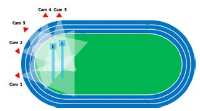
The purpose of the study was to investigate the relationship between the different kinematical variables with respect to the records and techniques performed by the participants during the 2011 Daegu IAAF World Championships Men's Pole Vault Event. Subjects chosen for the study were 8 male athletes who were selected for men's pole vault finals (highly skilled group) and 7 athletes who scored lowest record (skilled group) from the men's pole vault qualifying round. Personal best record of the each subjects were chosen to perform two dimensional (2D) and three dimensional (3D) video analyses. The data were obtained at 60 Hz with the use of five video cameras and digitizing was performed. Kinematical variables were calculated after smoothing the data using 2nd order Low-Pass Butterworth filter at cut-off frequency of 10 Hz and Independent samples t-test was performed to test any differences between two subject groups. The results: during the run-up stage, the horizontal velocity rate of the number of steps and run-up phase was obtained higher in highly skilled group than skilled group. During the take-off phase, deceleration in the horizontal velocity rate was observed in highly skilled group than skilled group. Distinct technical characteristics of distant and lower take-off of the take-off angle (angle of pole support) were also observed in highly skilled group than skilled group. During the pole bending and releasing phase, horizontal velocity was generally higher in highly skilled group than skilled group. It is considered that highly skilled group was able to jump higher as the vertical velocity during the pole bending as well as release phase was much higher in comparison to the skilled group.

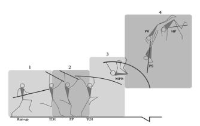
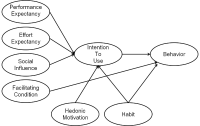
Purpose The purpose of this study was to investigate the factor that influence the using behavior of online sport media by university students applying Unified theory of acceptance and use of technology 2(UTAUT 2). Methods The study performed a research survey using convenient sampling method. The sample was 235 university students who had experience with online sport media. The data were analyzed through frequency analysis, reliability analysis, correlation analysis, confirmatory factor analysis, and structural equation model using SPSS Windows ver . 20.0 and AMOS 20.0. Results The results showed that, firstly, performance expectancy and effort expectancy had a positive effect on intention to use, however, no significant influence on social effect on intention to use. Secondly, facilitating condition had positive effect on usage behavior. Thirdly, hedonic motivation had positive effect on intention to use. Fourthly, Habit had positive effect on the intention to use and usage behavior. Lastly, intention to use had positive effect on usage behavior. Conclusion Based on the conclusion of this study, online sports media companies should provide useful and convenient viewing experience by providing personalized services, and should apply various attraction strategies to habitually use sports online media.

PURPOSE The purpose of this study is to analyze the biomechanical variables involved in ballet dancers’ ankle muscle imbalance when performing relevé movements. METHODS The subjects of this study (n=14, age: 22.29±1.73 years old, height: 161.4±5.06cm, weight: 51.88±7.51kg) were 14 ballet dancers with 9 years of experience. Based on the reciprocal muscle strength ratio, the dancers were divided into the following groups: Close to the normal value (RMIS) and far from the normal value (RMIB) using the maximum values of plantar flexion and dorsiflexion of the ankle joint using an isokinetic measurement equipment (60°/sec). RMIB). The biomechanical variables, namely the ankle joint movement and ground reaction force, were subsequently measured. SPSS 26.0 was used for data analysis and independent t-test was used for statistical verification. RESULTS The ground reaction force in the Z (vertical) direction based on the ankle joint muscle strength imbalance of ballet dancers was significantly lower in the RMIB group. In addition, although it was not a statistically significant difference, the plantar flexion movement was lower in the RMIB group, and there was a significant difference in the generation of ankle joint movement in the Z direction. CONCLUSIONS In conclusion, in order for a ballet dancer to efficiently utilize the force generated from the supporting leg when performing a movement, ankle imbalance must be taken into consideration when training.